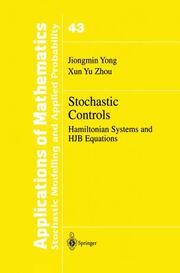Detailansicht
Stochastic Controls
Hamiltonian Systems and HJB Equations, Stochastic Modelling and Applied Probability 43
ISBN/EAN: 9780387987231
Umbreit-Nr.: 1091603
Sprache:
Englisch
Umfang: xxii, 439 S.
Format in cm:
Einband:
gebundenes Buch
Erschienen am 22.06.1999
- Zusatztext
- As is well known, Pontryagin's maximum principle and Bellman's dynamic programming are the two principal and most commonly used approaches in solving stochastic optimal control problems. * An interesting phenomenon one can observe from the literature is that these two approaches have been developed separately and independently. Since both methods are used to investigate the same problems, a natural question one will ask is the fol lowing: (Q) What is the relationship betwccn the maximum principlc and dy namic programming in stochastic optimal controls? There did exist some researches (prior to the 1980s) on the relationship between these two. Nevertheless, the results usually werestated in heuristic terms and proved under rather restrictive assumptions, which were not satisfied in most cases. In the statement of a Pontryagin-type maximum principle there is an adjoint equation, which is an ordinary differential equation (ODE) in the (finite-dimensional) deterministic case and a stochastic differential equation (SDE) in the stochastic case. The system consisting of the adjoint equa tion, the original state equation, and the maximum condition is referred to as an (extended) Hamiltonian system. On the other hand, in Bellman's dynamic programming, there is a partial differential equation (PDE), of first order in the (finite-dimensional) deterministic case and of second or der in the stochastic case. This is known as a Hamilton-Jacobi-Bellman (HJB) equation.
- Kurztext
- This book unifies the maximum principle and dynamic programming, the two most commonly used approaches in solving optimal control problems. The author shows that the viscosity solution theory provides the unifying framework.
- Autorenportrait
- Inhaltsangabe1. Basic Stochastic Calculus.- 1. Probability.- 1.1. Probability spaces.- 1.2. Random variables.- 1.3. Conditional expectation.- 1.4. Convergence of probabilities.- 2. Stochastic Processes.- 2.1. General considerations.- 2.2. Brownian motions.- 3. Stopping Times.- 4. Martingales.- 5. Itô's Integral.- 5.1. Nondifferentiability of Brownian motion.- 5.2. Definition of Itô's integral and basic properties.- 5.3. Itô's formula.- 5.4. Martingale representation theorems.- 6. Stochastic Differential Equations.- 6.1. Strong solutions.- 6.2. Weak solutions.- 6.3. Linear SDEs.- 6.4. Other types of SDEs.- 2. Stochastic Optimal Control Problems.- 1. Introduction.- 2. Deterministic Cases Revisited.- 3. Examples of Stochastic Control Problems.- 3.1. Production planning.- 3.2. Investment vs. consumption.- 3.3. Reinsurance and dividend management.- 3.4. Technology diffusion.- 3.5. Queueing systems in heavy traffic.- 4. Formulations of Stochastic Optimal Control Problems.- 4.1. Strong formulation.- 4.2. Weak formulation.- 5. Existence of Optimal Controls.- 5.1. A deterministic result.- 5.2. Existence under strong formulation.- 5.3. Existence under weak formulation.- 6. Reachable Sets of Stochastic Control Systems.- 6.1. Nonconvexity of the reachable sets.- 6.2. Noncloseness of the reachable sets.- 7. Other Stochastic Control Models.- 7.1. Random duration.- 7.2. Optimal stopping.- 7.3. Singular and impulse controls.- 7.4. Risk-sensitive controls.- 7.5. Ergodic controls.- 7.6. Partially observable systems.- 8. Historical Remarks.- 3. Maximum Principle and Stochastic Hamiltonian Systems.- 1. Introduction.- 2. The Deterministic Case Revisited.- 3. Statement of the Stochastic Maximum Principle.- 3.1. Adjoint equations.- 3.2. The maximum principle and stochastic Hamiltonian systems.- 3.3. A worked-out example.- 4. A Proof of the Maximum Principle.- 4.1. A moment estimate.- 4.2. Taylor expansions.- 4.3. Duality analysis and completion of the proof.- 5. Sufficient Conditions of Optimality.- 6. Problems with State Constraints.- 6.1. Formulation of the problem and the maximum principle.- 6.2. Some preliminary lemmas.- 6.3. A proof of Theorem 6.1.- 7. Historical Remarks.- 4. Dynamic Programming and HJB Equations.- 1. Introduction.- 2. The Deterministic Case Revisited.- 3. The Stochastic Principle of Optimality and the HJB Equation.- 3.1. A stochastic framework for dynamic programming.- 3.2. Principle of optimality.- 3.3. The HJB equation.- 4. Other Properties of the Value Function.- 4.1. Continuous dependence on parameters.- 4.2. Semiconcavity.- 5. Viscosity Solutions.- 5.1. Definitions.- 5.2. Some properties.- 6. Uniqueness of Viscosity Solutions.- 6.1. A uniqueness theorem.- 6.2. Proofs of Lemmas 6.6 and 6.7.- 7. Historical Remarks.- 5. The Relationship Between the Maximum Principle and Dynamic Programming.- 1. Introduction.- 2. Classical Hamilton-Jacobi Theory.- 3. Relationship for Deterministic Systems.- 3.1. Adjoint variable and value function: Smooth case.- 3.2. Economic interpretation.- 3.3. Methods of characteristics and the Feynman-Kac formula.- 3.4. Adjoint variable and value function: Nonsmooth case.- 3.5. Verification theorems.- 4. Relationship for Stochastic Systems.- 4.1. Smooth case.- 4.2. Nonsmooth case: Differentials in the spatial variable.- 4.3. Nonsmooth case: Differentials in the time variable.- 5. Stochastic Verification Theorems.- 5.1. Smooth case.- 5.2. Nonsmooth case.- 6. Optimal Feedback Controls.- 7. Historical Remarks.- 6. Linear Quadratic Optimal Control Problems.- 1. Introduction.- 2. The Deterministic LQ Problems Revisited.- 2.1. Formulation.- 2.2. A minimization problem of a quadratic functional.- 2.3. A linear Hamiltonian system.- 2.4. The Riccati equation and feedback optimal control.- 3. Formulation of Stochastic LQ Problems.- 3.1. Statement of the problems.- 3.2. Examples.- 4. Finiteness and Solvability.- 5. A Necessary Condition and a Hamiltonian System.- 6. Stochastic Riccati Equations.- 7. Global Solvability of Stocha
